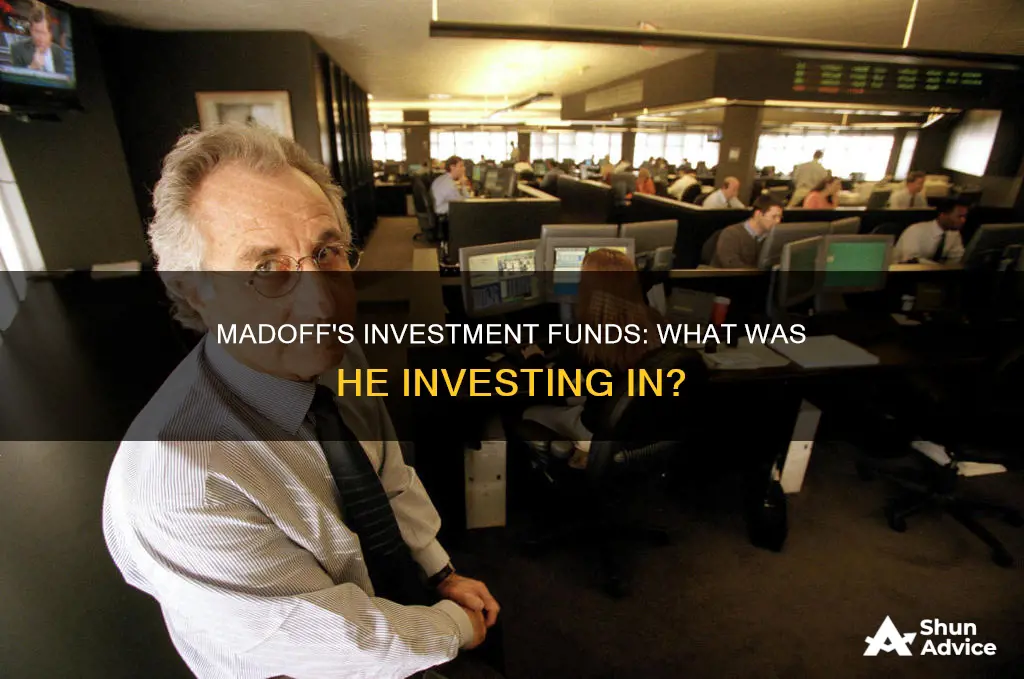
Bernie Madoff was an American financier who orchestrated the largest Ponzi scheme in history, defrauding thousands of investors out of an estimated £65 billion over the course of at least 17 years.
Madoff's fund, Bernard L. Madoff Investment Securities LLC, was a Ponzi scheme in which he deposited client funds into a single bank account that he used to pay existing clients who wanted to cash out. He funded the redemptions by attracting new investors and their capital.
Madoff attracted investors by claiming to generate large, steady returns through an investing strategy called split-strike conversion, a legitimate trading strategy. However, he was not actually investing his clients' money, and the fraud unravelled when the market turned sharply lower in late 2008 and too many clients sought to withdraw their money.
| Characteristics | Values |
|---|---|
| Type of scheme | Ponzi scheme |
| Amount missing from client accounts | $65 billion |
| Actual losses to investors | $18 billion |
| Amount recovered | $14.7 billion |
| Amount distributed to investors | $4.22 billion |
| Amount to be distributed | $372 million |
| Amount forfeited by Madoff | $170 billion |
| Amount forfeited by Jeffry Picower | $7.2 billion |
| Amount forfeited by JPMorgan Chase Bank N.A. | $1.7 billion |
| Amount forfeited by Carl Shapiro and family | N/A |
What You'll Learn

Fairfield Greenwich Group
The Fairfield Greenwich Group is an investment firm founded in 1983 in New York City. The firm had one of the largest exposures to the Bernard Madoff fraud.
In 1989, Walter M. Noel Jr., founder of the Fairfield Greenwich Group, was introduced to Madoff by Tucker's father-in-law, who knew Madoff and had invested with him. Noel and his partner, Jeffrey Tucker, created the Fairfield Sentry fund in 1990 with $1 million in "seed money", and began expanding it a year later. The fund required a $100,000 minimum investment and was billed as a way to tap into Madoff's trading expertise. It had more than $7 billion invested with Madoff and became one of his largest victims.
In 2006, the Securities and Exchange Commission (SEC) determined that Fairfield Greenwich had not properly disclosed that Madoff oversaw its investment decisions, though no evidence of fraud was found. Subsequently, the firm formally disclosed Madoff's role and in the process raised about $1.7 billion from investors in the US and Europe. By 2008, the firm had 48% of its capital tied to Madoff.
In 2008, Fairfield Greenwich reported more than $14 billion in assets under management. However, the firm's relationship with Madoff led to significant losses and legal troubles. Fairfield Greenwich was named as a defendant in a class action lawsuit seeking to recoup losses resulting from its investments with Madoff. The firm was also sued by Irving Picard, the trustee liquidating Madoff's assets, seeking the return of $3.2 billion.
In addition to financial losses, the fallout from the Madoff scandal also impacted the personal lives of Fairfield Greenwich executives. Noel and Tucker sold assets, including a shared interest in a private jet and horse farms. Several Fairfield Greenwich executives were forced to sell their homes at a loss due to the scandal.
The Fairfield Greenwich Group's involvement with Madoff highlights the significant impact that the fraud had on investors and businesses. The firm's exposure to Madoff's scheme resulted in financial and legal consequences, as well as personal disruptions for its executives.
Mutual Funds: India's Smart Investment Choice
You may want to see also

Tremont Capital Management
In July 2011, Tremont Group agreed to pay a $1 billion cash settlement after being sued by Irving Picard, the court-appointed trustee in the Madoff bankruptcy. Picard alleged that Tremont failed to perform independent, reasonable, and meaningful due diligence of Madoff.
Strategies for Investing in Sovereign Wealth Funds
You may want to see also

Banco Santander
Optimal, Santander's fund-management arm, told its institutional investors in a report that Madoff had an ability "to find great entry and exit points to benefit investors". However, US regulators believe that Madoff never made a single trade and instead used cash from new investors to fund payments to earlier clients.
The bank had two funds with $2.1 billion invested with Madoff. Santander is offering its private banking clients 1.38 billion euros in compensation for Madoff-related losses. The offer doesn't apply to institutional investors. Santander customers Mar Octava Limitada and Marcelo Guillermo Testa filed a class-action lawsuit in a U.S. court.
Latin American clients were approached with an offer to return their original investments via preferred stock with a 2% interest rate, in return for a promise not to sue. Santander's clients face total losses of €2.3 billion.
Baron Asset Fund: Open for Investment?
You may want to see also

Bank Medici
In December 2008, Bank Medici reported that two of its funds—Herald USA Fund and Herald Luxemburg Fund—were exposed to Madoff losses. On January 2, 2009, FMA, the Austrian banking regulator, took control of Bank Medici and appointed a supervisor to control the bank. Bank Medici was sued by its customers in the U.S. and in Austria. The Vienna State Prosecutor launched a criminal investigation of Bank Medici and Kohn, who had invested an estimated $2.1 billion with Madoff. On May 28, 2009, Bank Medici lost its Austrian banking licence. Kohn and the bank were under investigation, but she was not accused of criminal wrongdoing.
A Beginner's Guide to UAE Mutual Fund Investing
You may want to see also

ALMUS Partners
The exact amount of money that ALMUS Partners channelled into Madoff's firm is unclear. However, it is known that the firm was one of eight investors with the largest potential losses, which totalled $21.32 billion. ALMUS Partners was listed as having $1.65 billion in potential losses.
The court-appointed trustee, Irving Picard, estimated the actual losses to investors at $18 billion, and much of that money has been returned. Picard has been locating assets for distribution to investors. As of March 2024, the trustee had recovered $14.7 billion toward these claims through legal action against Madoff associates, feeder funds and beneficiaries of the scheme.
In addition to the $14.7 billion recovered by Picard, action by the Department of Justice has recovered an additional $4 billion. As of September 2022, the Madoff Victim Fund had distributed over $4 billion to more than 40,000 victims as compensation for losses they suffered from the collapse of Bernard L. Madoff Investment Securities LLC.
Investing in Bharat 22 ETF: A Comprehensive Guide
You may want to see also
Frequently asked questions
Madoff did not invest in any funds. He ran a Ponzi scheme, defrauding investors out of an estimated £65 billion.
Madoff claimed to generate large, steady returns through an investing strategy called split-strike conversion, a legitimate trading strategy.
Madoff's investors believed they were putting their money into blue-chip stocks.







